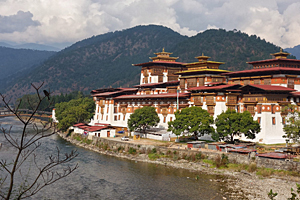| 7 December | Attendee arrivals in Bangkok, Thailand (BKK) – Group stays at Novotel Airport Hotel |
| 8 December | Group flight departure from Bangkok, Thailand (BKK) to Bhutan at 7:20 AM – Arrives in Bhutan at 10:45 AM |
| 8-10 December | Thimphu, Bhutan (Taj Tashi Hotel) |
| 10 December | Day trip to Punkaha, Bhutan |
| 11-12 December | Paro, Bhutan (Zhiwaling Hotel) |
| 13 December | Group flight departure from Bhutan to Bangkok, Thailand (BKK) at 11:40 AM – Arrives in Bangkok (BKK) at 4:40 PM |
Program Highlights
THIMPHU: The Kingdom’s capital city is home to approximately 100,000 inhabitants including the Royal family. This bustling little city is the main center of commerce, religion and government in the country. One of the most curious features of Thimphu is that it is the only capital city in the world that does not use traffic lights. Instead, a few major intersections have policemen standing in elaborately decorated booths (small pavilions), directing traffic with exaggerated hand motions. The juxtaposition of ancient tradition and modernity make Thimphu the ideal location for travelers to break away from their tour itinerary and immerse themselves in the lifestyle of contemporary Bhutanese.
PUNAKHA: (The ethereal ancient capital): Punakha has been inextricably linked with momentous occasions in Bhutanese history. On 13 October, 2011 the district of Punakha was home to the auspicious and historical Royal wedding. Punakha served as the capital of the country from 1637 to 1907, and the first national assembly was hosted here in 1953. The Punakha Dzong (Fort) is the second oldest and second largest in Bhutan and one of the most majestic structures in the country.
PARO: The valley extends from the confluence of the Paro Chhu and the Wang Chhu rivers at Chuzom up to Mt. Jomolhari at the Tibetan border to the North. This picturesque region is one of the widest valleys in the kingdom and is covered in fertile rice fields featuring a beautiful, crystalline river.
TAKTSANG MONASTERY (TIGER’S NEST): Taktsang Monastery is Bhutan’s most iconic landmark and religious site. The name Taktsang translates to “The Tiger’s Nest”. This monastery is one of the most holy sites in the Kingdom and clings impossibly to a sheer cliff, 900 hundred meters above the Paro Valley. It was first built in 1692 at a cave where Guru Rimpoche meditated in the 7th century A.D. Legend states that Guru Rimpoche flew to the site atop the back of a tigress and meditated in the cave for 3 years, 3 months, 3 days and 3 hours in order to subdue evil demons residing within it. The cave has been considered a sacred site ever since, and many famous saints have traveled to meditate in it.



